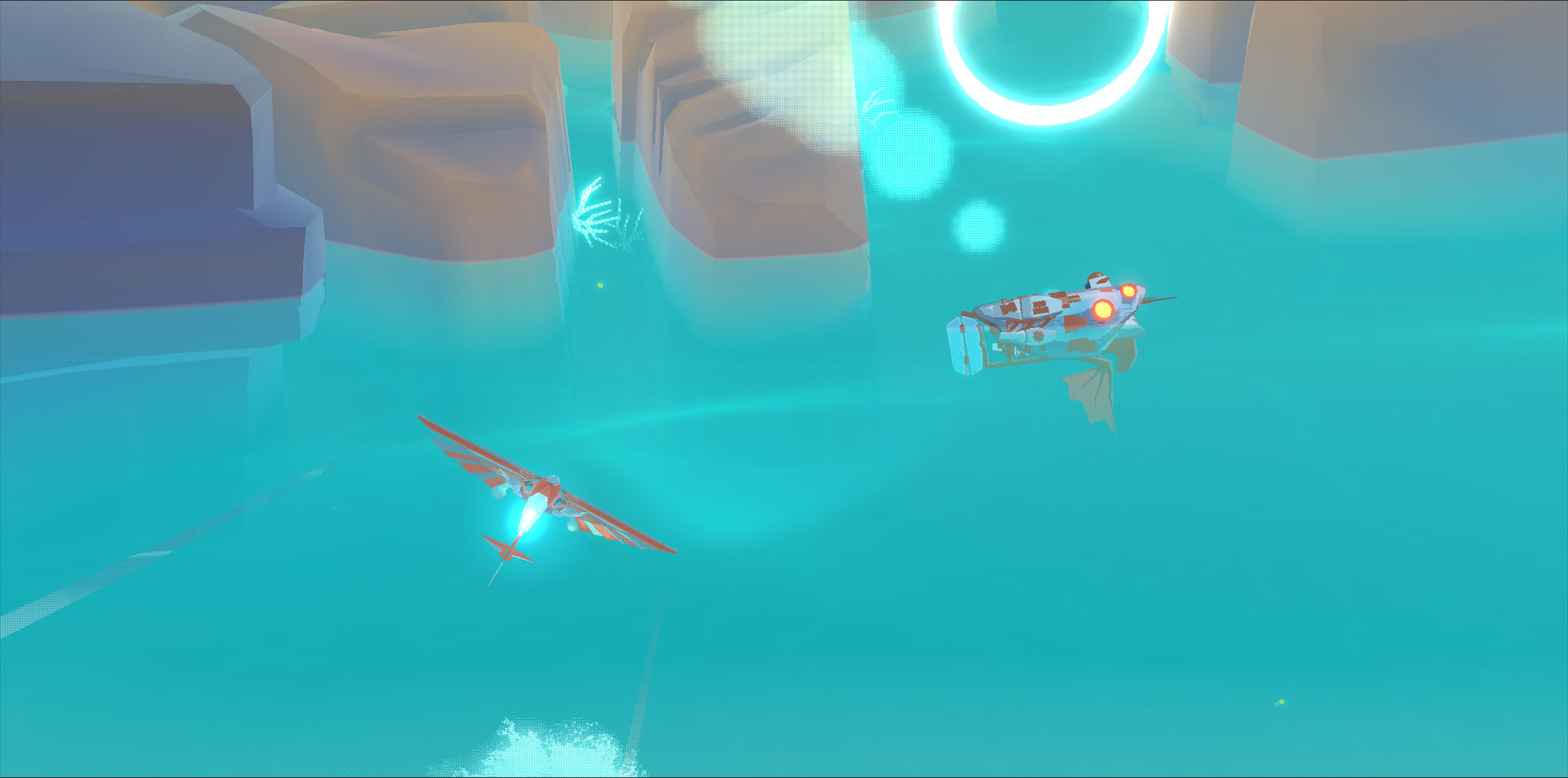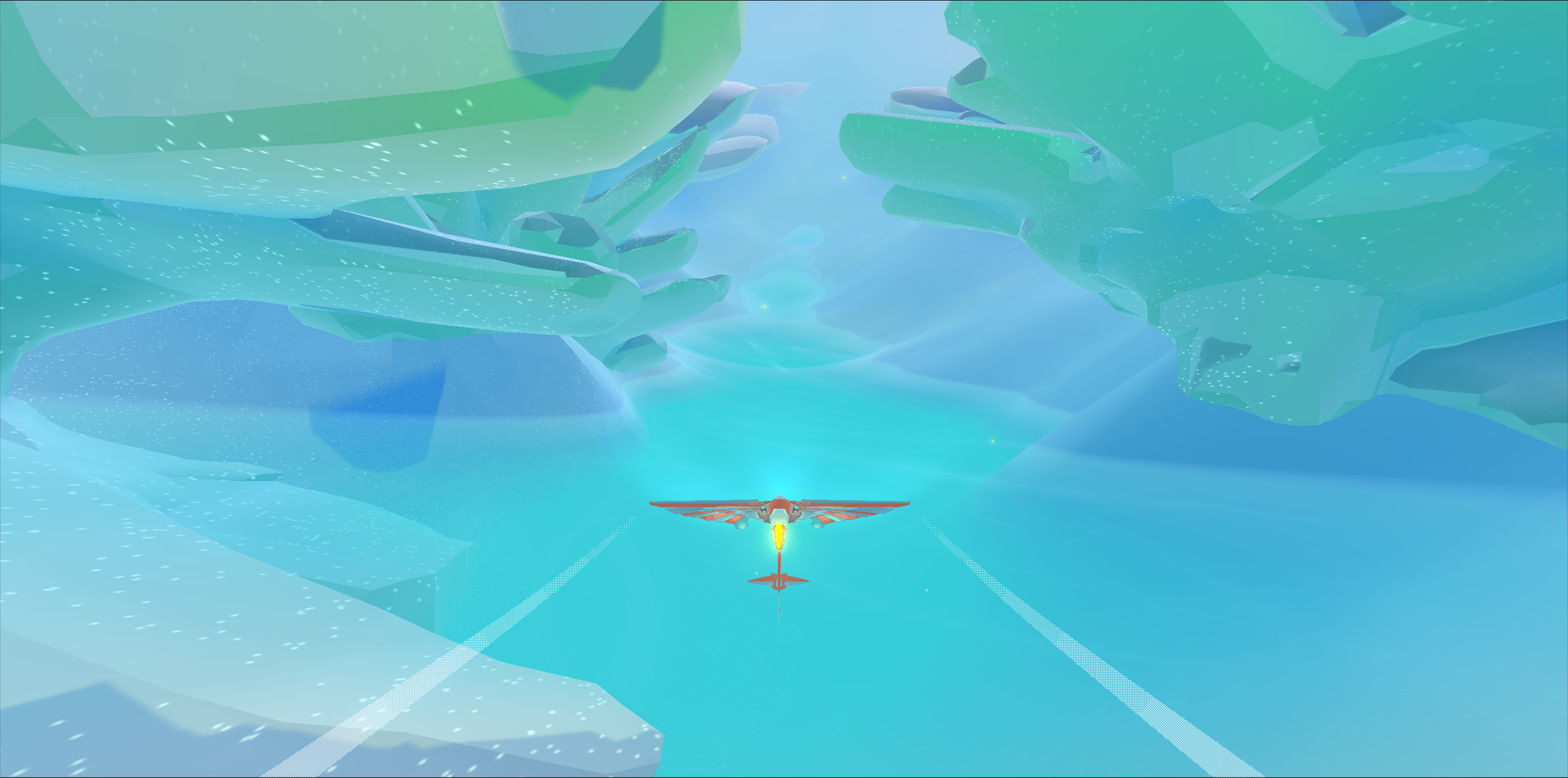InnerSpace is an exploration flying game for PC, Mac, and Linux. Set in a world where physics are inverted, the player flies in a spherical world surrounded by water, where gravity falls away from the center. Take the role of an unnamed cartographer to explore the various bubble-worlds, collect relics, and encounter each bubble’s mythical demigod, in order to discover more about the universe, its history, and its future.
Our end goal was to create a game that encouraged exploration by the player’s volition, as in games like Proteus, Journey, and Minecraft, while delivering a mechanically satisfying experience. This is done by providing an interesting vehicle for action, the plane, and by bringing you to epic encounters with powerful creatures tied closely to the worlds they inhabit. In this way, InnerSpace feels like a mix between Proteus and Shadow of the Colossus.
Flying in InnerSpace is designed to be fun and never frustrating. When playing, you should be able to observe and learn about the world without ever worrying about accidentally crashing because of frustrating controls. Since the world disregards our own world’s physics, the plane flies free from the rules of gravity, which allows you to focus on the experience of exploring, instead of worrying about staying upright.
Stalling/Air Drifting
To keep the plane agile for easier maneuvering, the plane can stall, which allows you to slow down, turn in any direction, and start flying again. Stalling is borrowed from racing mechanics, and almost feels like “air drifting.” Just like drifting in racing games, stalling lets you face a direction before actually moving towards it, all while retaining momentum. Mastering this mechanic is the key to executing faster and sharper turns, allowing you to traverse tighter and more difficult passages.
Diving
Diving allows you to experience the world of InnerSpace from an entirely different perspective. Throughout the game, we emphasize the distinction between air and water, yet as the cartographer, you’re able to seamlessly transition between the two different areas, effectively connecting the two.
World Interaction
A main focus of InnerSpace is the expression of narrative through the interaction between the player and the environment.
Destructible Environments- Parts of the environment, such as degraded walls or old pillars, can be destroyed in order to open new areas or, perhaps, to confound enemies in pursuit.
Wing Blades- The cartographer’s plane can extend the effective reach of its wingspan by extending wing blades. These blade wings allow you to solve puzzles, destroy structures, and trigger events.
The Bosses/ Demigods
Imagine taking notice of a giant, whale-like behemoth swimming in the ocean below. The player may ignore it, attack it, or simply observe it. Eventually, the interaction with it may intensify, but not always through hostility. Encounters with the deities aren’t just boss battles. Instead, they’re the stage for incredible cinematic experiences, in which you come into direct contact with the very pillars of life in the realms of InnerSpace.
Exploration
In InnerSpace, exploration takes center stage. We’ve found that exploration in open-world games often harbor a tension between stretches of scripted story missions and open exploration. It’s often more interesting to pursue your own interests, sometimes in spite of the narrative. With InnerSpace, we wanted to erase the dichotomy between the two, interweaving the intrigue of a story with the thrill of finding and pursuing new expanses.Our end goal was to create a game that encouraged exploration by the player’s volition, as in games like Proteus, Journey, and Minecraft, while delivering a mechanically satisfying experience. This is done by providing an interesting vehicle for action, the plane, and by bringing you to epic encounters with powerful creatures tied closely to the worlds they inhabit. In this way, InnerSpace feels like a mix between Proteus and Shadow of the Colossus.
Gameplay
FlyingFlying in InnerSpace is designed to be fun and never frustrating. When playing, you should be able to observe and learn about the world without ever worrying about accidentally crashing because of frustrating controls. Since the world disregards our own world’s physics, the plane flies free from the rules of gravity, which allows you to focus on the experience of exploring, instead of worrying about staying upright.
Stalling/Air Drifting
To keep the plane agile for easier maneuvering, the plane can stall, which allows you to slow down, turn in any direction, and start flying again. Stalling is borrowed from racing mechanics, and almost feels like “air drifting.” Just like drifting in racing games, stalling lets you face a direction before actually moving towards it, all while retaining momentum. Mastering this mechanic is the key to executing faster and sharper turns, allowing you to traverse tighter and more difficult passages.
Diving
Diving allows you to experience the world of InnerSpace from an entirely different perspective. Throughout the game, we emphasize the distinction between air and water, yet as the cartographer, you’re able to seamlessly transition between the two different areas, effectively connecting the two.
World Interaction
A main focus of InnerSpace is the expression of narrative through the interaction between the player and the environment.
Destructible Environments- Parts of the environment, such as degraded walls or old pillars, can be destroyed in order to open new areas or, perhaps, to confound enemies in pursuit.
Wing Blades- The cartographer’s plane can extend the effective reach of its wingspan by extending wing blades. These blade wings allow you to solve puzzles, destroy structures, and trigger events.
The Bosses/ Demigods
Imagine taking notice of a giant, whale-like behemoth swimming in the ocean below. The player may ignore it, attack it, or simply observe it. Eventually, the interaction with it may intensify, but not always through hostility. Encounters with the deities aren’t just boss battles. Instead, they’re the stage for incredible cinematic experiences, in which you come into direct contact with the very pillars of life in the realms of InnerSpace.
Minimum Setup
- OS: Ubuntu 16.04 / SteamOS
- Processor: AMD A8-7600 (3.1 GHz) OR Intel Core i3 4170 (3.7 GHz)Memory: 8 GB RAM
- Memory: 8 GB RAM
- Graphics: Nvidia GPU GeForce GTX 650 / AMD GPU Radeon R9 290
- Storage: 5 GB available spaceAdditional Notes: 1 GB VRAM
GAMEBILLET
[ 6420 ]
FANATICAL
[ 7154 ]
GAMERSGATE
[ 3653 ]
MacGameStore
[ 5363 ]
FANATICAL BUNDLES
HUMBLE BUNDLES
by buying games/dlcs from affiliate links you are supporting tuxDB










































